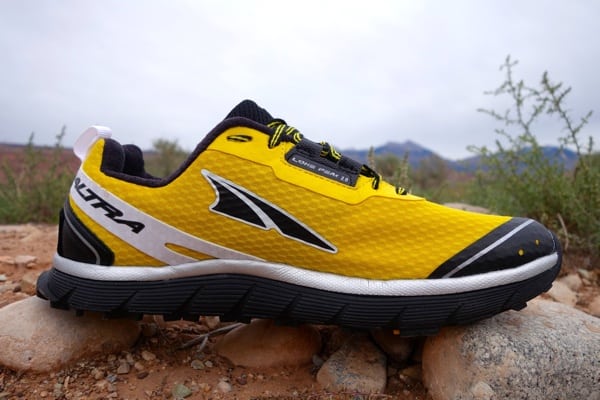Check out our Altra Lone Peak 9 review for the latest on the Lone Peak family of trail running shoes.
Our Favorite Trail Running Shoes
Check out our Best Trail Running Shoes article to learn about our current favorite trail running shoes!
Altra Lone Peak 2.0 Review
Altra has been a very fast-moving and innovative company since opening its doors in 2009. Sales have expanded exponentially and their presence is inescapable at trail and ultra races, at least in the Rocky Mountain region. After getting to meet and interview co-founder, Golden Harper, at last year’s Outdoor Retailer show in Salt Lake City, I can understand the fervor. This really is a company founded by runners for runners and they’ve found a way to maintain the core integrity, personnel, and mission of their company after selling the brand to a much larger company, all the while producing very high quality shoes.
While previewing the newest line of Altra shoes at OR, I noticed upgrades in manufacturing and construction of the shoes, but, especially, the improved EVA compounds and innovative placement of the StoneGuard (rock plate) in the shoes. The latest data shows that Altra’s sales currently rate them seventh out of the running-specialty manufacturers, and this latest round of road and trail running shoes, including the Altra Lone Peak 2.0 ($120), prime the company to move higher up in this list.

The Altra Lone Peak 2.0.
Upper
The changes in the quality of material are most evident in the upper of the Lone Peak. We’ve seen the upper evolve from a porous and somewhat stiff material to one of the softest and most durable uppers on the market. Fit has changed to offering a foot-hugging midfoot and locked-in heel. My initial worry with this upper was that it was so soft and roomy it almost provided the illusion of feeling like bedroom slippers. Just as in the first version of the Lone Peak, I found myself reaching for this shoe not only for daily runs, but also to take the kids for a hike and on errands around town. It was hard to imagine how a shoe could be so roomy and accommodating while still offering plenty of support on technical trails. Thankfully, the forward slippage I’d imagined never materialized and the Lone Peak 2.0 is the most comfortable and relaxed-fitting upper on the market that still manages to keep the foot secure on steep downhills.

The Altra Lone Peak 2.0’s lateral upper.
Altra redesigned the toe bumper of the Lone Peak with a lightweight rubber compound welded overlay which reduces weight and still provides plenty of protection. The lacing system is simple yet effective, and there is nary a seam on the entire upper which would irritate even the most fickle foot. On the heel of the shoe, they previously added (in the 1.5) a GaiterTrap, which is a small Velcro flap that alleviates the need to apply a sticky Velcro strip when one decides to train or race with gaiters. I tried this feature out with my Dirty Girl gaiters and it did feel more secure than using aftermarket Velcro to stick onto the shoe.
Despite the dual-density mesh of the Lone Peak 2.0 being very durable, and even feeling a bit thick, the shoe did not feel hot on my feet during long runs in 85-plus-degree Fahrenheit weather. However, this did inhibit the upper from draining efficiently, and after water crossings, I timed that it took the Lone Peak around 30 minutes to lose that squishy, wet feeling.
Midsole
The cushioning of the Lone Peak increased significantly, almost hinting of a ‘maximalist’ running shoe. Altra uses their A-Bound EVA, which is an environmentally friendly midsole material, and they use LOADS of it. I never owned or tried on the Lone Peak 1.5, but when I ran in the original Lone Peak versus the 2.0, the difference was night and day. A-Bound is a softer-durometer EVA which seems to remain uncompressed despite hundreds of hard trail miles. Additionally, Altra designed the 2.0 to have a StoneGuard (in between two layers of midsole) that is longer than traditional rock plates and extends laterally to protect the fifth metatarsal. Traditional design places a rock plate between the midsole and outsole which can cause instability in the shoe whereas the Lone Peak 2.0 allows the A-Bound midsole material to take the brunt of the impact and the StoneGuard protects on the back end. In my opinion, this is the best rock-plate design on the market and it allows the midsole material to shine while providing protection without creating a stiff or unresponsive shoe.

The Altra Lone Peak 2.0’s medial upper.
I would describe the cushioning of the Lone Peak 2.0 to almost be Hoka-esque in its protection. A-Bound is softer durometer but not squishy, and it does allow a bit of ground feel. If the original Lone Peak is a “smooth riding 1970s Continental,” as I described it, then the 2.0 features upgraded shocks that seem to float over rough terrain. Comparing the original Lone Peak and the 2.0 midsole is nearly impossible due almost double the cushioning at the same weight.
Outsole
Altra employs a slightly modified TrailClaw outsole which features slightly larger lugging, but overall the same scheme. I’ve read some reviews of this outsole that state that it does not do well on rocky and technical surfaces, but this is a verdict with which I disagree. I found the outsole to be equally effective on hard pack and rocky surfaces, while having a similar shortcoming as most trail shoes in mud. One feature which greatly increases traction is the addition of X-shaped lugs on the medial and lateral exterior of the outsole that extend from the midfoot to the heel. When taking corners in loose rock or dirt, these seemed to grip the trail extremely well.

Altra Lone Peak 2.0’s outsole.
Overall Impressions
I recently had a number of runners and family members seek out my advice regarding the need for wider toe boxes. While these folks were not avid runners, they were looking for roomier toe boxes after feeling constricted by their traditional-width ASICS and Brooks road shoes. Feet flatten and expand as we get older, and these casual runners were experiencing the same constraints that all of us will feel as we age into our 50s and 60s along with the added bunions, corns, and arthritis which make cramming your foot into a traditionally tapered last a bit painful. I suggested Altra running shoes to all of them and the rave reviews I received were unanimous. The foot-shaped toe box is a design we first saw hinted at in New Balance’s minimalist last, and, frankly, I’m surprised that every brand does not follow suit with more of a foot-shaped last. While not sexy in the conventional sense of shoe design, it simply makes sense.
The Lone Peak 2.0 is a limousine for the feet, offering very plush cushioning with a natural ride and flexibility not typically found in shoes with this much protection. The fit is loose yet secure, plush but adding ground feel, built like a tank. While I initially scoffed at the 11.4-ounce weight, I appreciated the added cushioning and smooth ride on longer trail runs and adventures where speed was not the objective. If I were to have a multi-day through hike or fastpacking trip, stage race, or long-trail attempt on my calendar, the Lone Peak 2.0 would be one of my top picks. I also think the combination of a zero drop along with superior plush cushioning, an upper that allows swelling, and smooth ride make the Lone Peak 2.0 an ideal ultra shoe for the 100-mile distance.
Call for Comments (from Meghan)
- Have you run in the Altra Long Peak 2.0? If so, what are your thoughts on the shoe as compared to Tom’s review?
- For those who have run in the original Lone Peak and the 1.5, how is the 2.0 different for you?
